前言
Android中应用加载Unity3D来显示3D效果参考上一篇博文:Unity3D导出Android工程(Android中应用Unity3D) 透明背景实现参考另一篇博文:
在Android中Unity3D透明背景的实现
此篇围绕上篇章来打造Andorid车载3D桌面,实现不一样的系统主界面效果。
Unity车模脚本定义与绑定
在Unity中,Assets下新建C#脚本,下面为车模控制的脚本,包含四个车门、四个车轮、车身旋转的控制:
using UnityEngine;
public class CarMain : MonoBehaviour
{
//车门对象
public GameObject doorFl;
public GameObject doorFr;
public GameObject doorRl;
public GameObject doorRr;
private bool door_fl_open;
private bool door_fr_open;
private bool door_rl_open;
private bool door_rr_open;
//车模自动旋转
public bool auto_rotate;
//车模对象
public GameObject car;
//车轮对象
public GameObject wheelFl;
public GameObject wheelFr;
public GameObject wheelRl;
public GameObject wheelRr;
//车轮转动
public bool wheel_run;
// Start is called before the first frame update
void Start()
{
}
// Update is called once per frame
void Update()
{
if(auto_rotate)
{
car.transform.Rotate(Vector3.up * 1);
}
if(wheel_run)
{
wheelFl.transform.Rotate(Vector3.up * 2);
wheelFr.transform.Rotate(Vector3.up * 2);
wheelRl.transform.Rotate(Vector3.up * 2);
wheelRr.transform.Rotate(Vector3.up * 2);
}
}
//以下为Android调用Unity方法
public void AutoRotate()
{
auto_rotate = !auto_rotate;
}
public void OpenDoorFl()
{
if(door_fl_open) return;
door_fl_open = true;
doorFl.transform.Rotate(new Vector3(0,90,0));
}
public void CloseDoorFl()
{
if(!door_fl_open) return;
door_fl_open = false;
doorFl.transform.Rotate(new Vector3(0,-90,0));
}
public void OpenDoorFr()
{
if(door_fr_open) return;
door_fr_open = true;
doorFr.transform.Rotate(new Vector3(0,-90,0));
}
public void CloseDoorFr()
{
if(!door_fr_open) return;
door_fr_open = false;
doorFr.transform.Rotate(new Vector3(0,90,0));
}
public void OpenDoorRl()
{
if(door_rl_open) return;
door_rl_open = true;
doorRl.transform.Rotate(new Vector3(0,90,0));
}
public void CloseDoorRl()
{
if(!door_rl_open) return;
door_rl_open = false;
doorRl.transform.Rotate(new Vector3(0,-90,0));
}
public void OpenDoorRr()
{
if(door_rr_open) return;
door_rr_open = true;
doorRr.transform.Rotate(new Vector3(0,-90,0));
}
public void CloseDoorRr()
{
if(!door_rr_open) return;
door_rr_open = false;
doorRr.transform.Rotate(new Vector3(0,90,0));
}
public void WheelRun()
{
wheel_run = !wheel_run;
}
}此脚本仅供参考,根据模型来定制,定义了Android调用Unity方法来控制模型旋转。主要通过.transform.Rotate()方法来控制车模部件的旋转来实现预期效果。Vector3.up代表绕Y轴旋转,new Vector3(x, y, z)代表x,Y,z轴的旋转角度,new Vector3(0,90,0)代表绕Y轴顺时针旋转90度。
定义了此脚本后,拖拽绑定到主车模,接着给各个对象选择对应到实际的车模部件上。

绑定成功后,生成android模块应用到android工程中,即可调用UnityPlayer的接口来调用Unity的脚本方法。
一个注意点:
车模旋转时由于坐标轴中心点不在车模中间,C#脚本中绑定了车模会使车模不是绕着中心旋转。此时需要右键create Empty创建一个空的模型(Car360),把它移动到车模中间位置,然后把车模移动嵌套到空模型(Car360)下,将C#脚本中的车模对象绑定到空模型(Car360),这样就以空模型(Car360)为中心点
360度旋转。

Android端的定制
接下来将生成android模块导入AndroidStudio,修改UnityPlayerActivity,新增自定义布局的适配。
@Override
protected void onCreate(Bundle savedInstanceState) {
requestWindowFeature(Window.FEATURE_NO_TITLE);
super.onCreate(savedInstanceState);
String cmdLine = updateUnityCommandLineArguments(getIntent().getStringExtra("unity"));
getIntent().putExtra("unity", cmdLine);
mUnityPlayer = new UnityPlayer(this, mLifecycleEvents);
if (getLayoutId() > 0) {
mContentView = LayoutInflater.from(this).inflate(getLayoutId(), null, false);
setContentView(mContentView);
int res_id = getResources().getIdentifier("layout_unity_content", "id", getPackageName());
ViewGroup contentUnityLayout = mContentView.findViewById(res_id);
if (contentUnityLayout != null) {
contentUnityLayout.addView(mUnityPlayer);
} else if (mContentView instanceof ViewGroup) {
((ViewGroup) mContentView).addView(mUnityPlayer);
} else {
mContentView = mUnityPlayer;
}
setContentView(mContentView);
} else {
mContentView = mUnityPlayer;
setContentView(mUnityPlayer);
}
mUnityPlayer.requestFocus();
init();
}主app通过继承UnityPlayerActivity重写getLayoutId()方法来加载自定义布局,重写init()方法来进行初始化操作,通过getContentView()来获取Activity的布局。
protected View getContentView() {
return mContentView;
}
protected int getLayoutId() {
return -1;
}
protected void init() {
}可视情况增加一个方法addCustomView()来添加布局:
protected void addCustomView(View view) {
((ViewGroup) mContentView).addView(view);
}MainActivity主入口继承UnityPlayerActivity,具体参考上一篇博客。
public class MainActivity extends UnityPlayerActivity implements View.OnClickListener重写getLayoutId()和init()方法,实现自定义布局。
自定义布局如下:
<?xml version="1.0" encoding="utf-8"?>
<FrameLayout xmlns:android="http://schemas.android.com/apk/res/android"
android:orientation="vertical"
android:layout_width="match_parent"
android:layout_height="match_parent">
<ImageView
android:id="@+id/iv_background"
android:layout_width="match_parent"
android:layout_height="match_parent"
android:background="@android:color/black"/>
<FrameLayout
android:id="@+id/layout_unity_content"
android:layout_width="match_parent"
android:layout_height="match_parent"/>
<Button
android:id="@+id/btn_switch_background"
android:layout_width="wrap_content"
android:layout_height="wrap_content"
android:text="切换背景"
android:layout_gravity="end"/>
<TextView
android:layout_width="wrap_content"
android:layout_height="wrap_content"
android:text="车辆信息:我的小车"
android:textColor="@android:color/holo_red_dark"
android:layout_marginBottom="20dp"
android:layout_gravity="center_horizontal|bottom"/>
</FrameLayout>其中layout_unity_content为添加UnityPlayer的容器,可以在容器前或后添加自定义控件或布局。
android调用Unity
为控件添加点击事件来控制车模:
if (id == R.id.btn_open_door_fl) {
sendUnityMessage("OpenDoorFl");
} else if (id == R.id.btn_close_door_fl) {
sendUnityMessage("CloseDoorFl");
} else if (id == R.id.btn_open_door_fr) {
sendUnityMessage("OpenDoorFr");
} else if (id == R.id.btn_close_door_fr) {
sendUnityMessage("CloseDoorFr");
} else if (id == R.id.btn_open_door_rl) {
sendUnityMessage("OpenDoorRl");
} else if (id == R.id.btn_close_door_rl) {
sendUnityMessage("CloseDoorRl");
} else if (id == R.id.btn_open_door_rr) {
sendUnityMessage("OpenDoorRr");
} else if (id == R.id.btn_close_door_rr) {
sendUnityMessage("CloseDoorRr");
} else if (id == R.id.btn_auto_rotate) {
sendUnityMessage("AutoRotate");
} else if (id == R.id.btn_wheel_run) {
sendUnityMessage("WheelRun");
}sendUnityMessage方法是对UnityPlayer.UnitySendMessage(s1, s2, s3)的封装。
private void sendUnityMessage(String s) {
sendUnityMessage("CarMain", s, "");
}
protected void sendUnityMessage(String s1, String s2, String s3) {
UnityPlayer.UnitySendMessage(s1, s2, s3);
}来看下效果
打开车门效果:
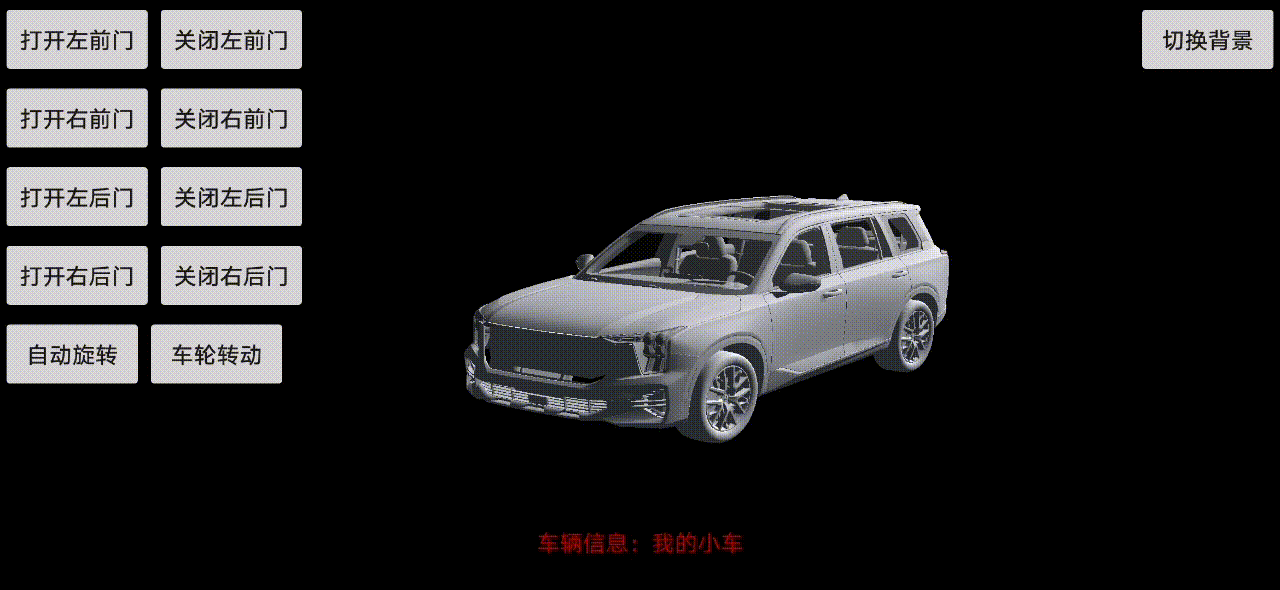
自动旋转效果:
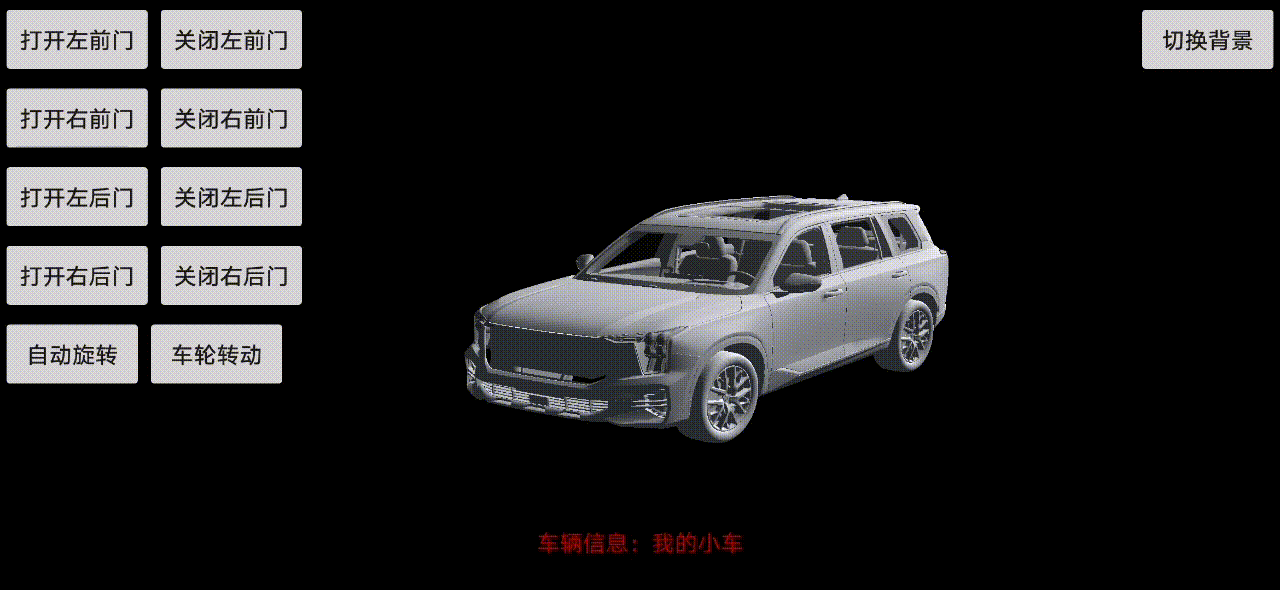
车轮转动效果:
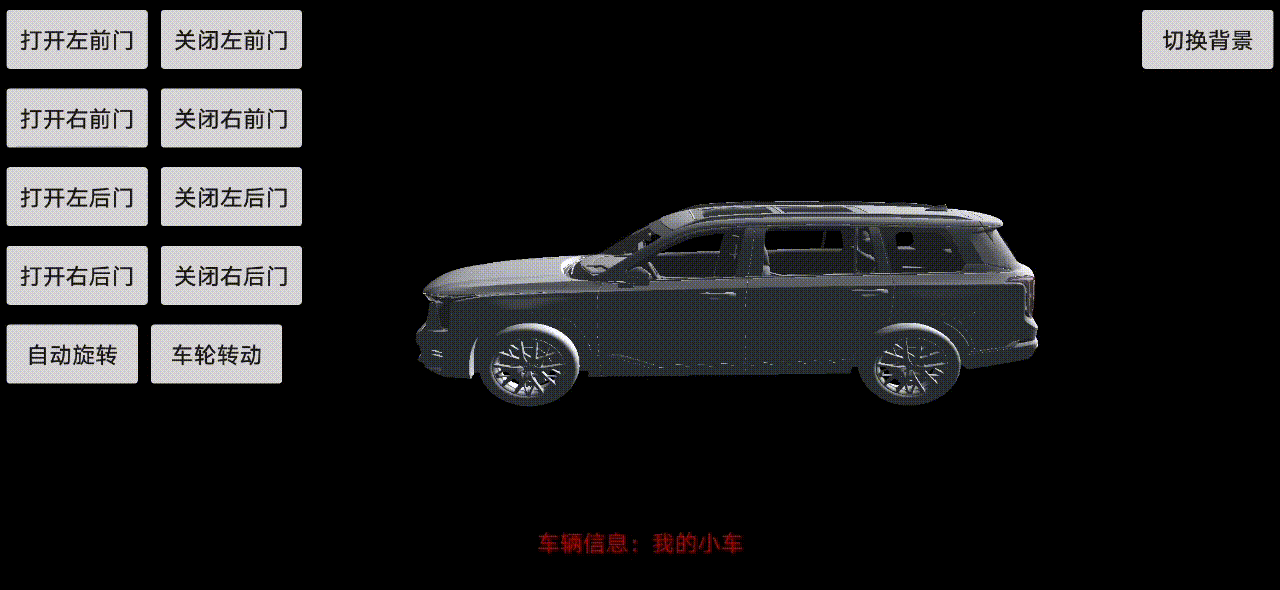
额外增加切换背景,可以通过切换背景实现不同的场景效果。
else if (id == R.id.btn_switch_background) {
mColorStatus++;
if (mColorStatus > 4) {
mColorStatus = 0;
}
mIvBackground.setBackgroundColor(getColorRes(mColorStatus));
}切换背景效果:
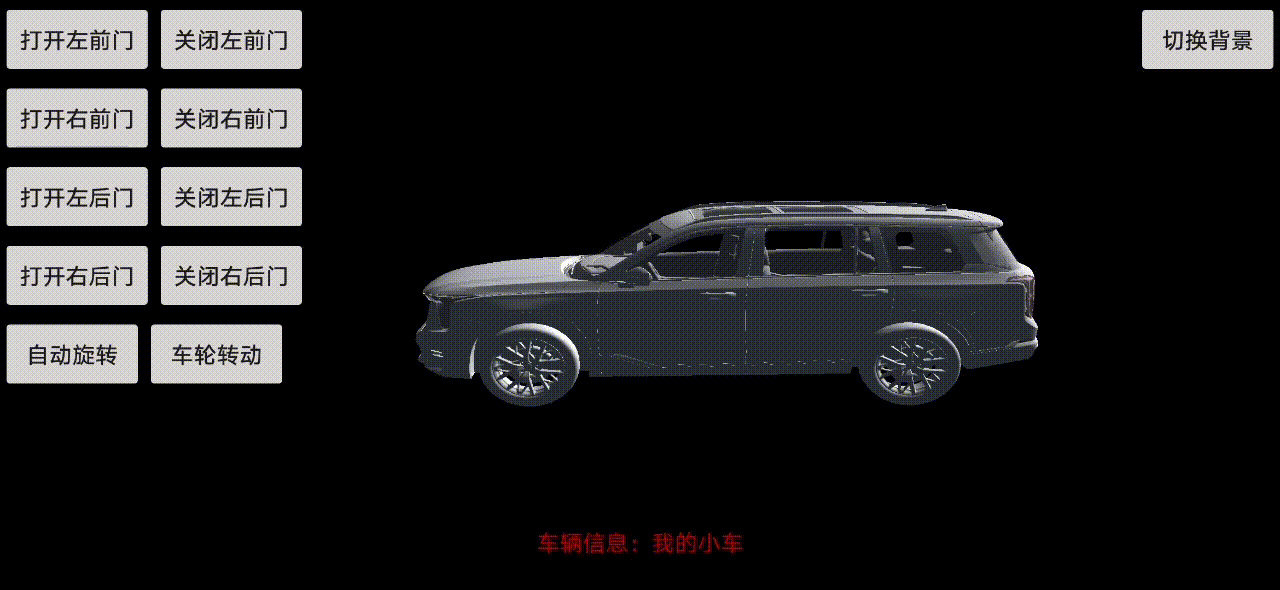
其中透明背景参考另一篇博文:
在Android中Unity3D透明背景的实现
触摸360度旋转的实现
触摸选装的C#脚本如下:
using UnityEngine;
using System.Collections;
public class TouchRotate : MonoBehaviour {
private bool isRotating=false;
public float rotateSpeed=1;
// Use this for initialization
void Start() {
}
// Update is called once per frame
void Update() {
RotateView();
}
void RotateView()
{
//Input.GetAxis("Mouse X");得到鼠标/触摸点在水平方向的滑动
//Input.GetAxis("Mouse Y");得到鼠标/触摸点在垂直方向的滑动
if (Input.GetMouseButtonDown(0)) {//0代表鼠标左键,1代表鼠标右键2代表鼠标中键 ,触摸时为0
isRotating=true;
}
if (Input.GetMouseButtonUp(0)) {
isRotating=false ;
}
if (isRotating) {
transform.RotateAround(transform.position ,Vector3.up,rotateSpeed*Input.GetAxis("Mouse X"));
}
}
}主要通过Input事件输入来监听触碰点,GetMouseButtonDown()和GetMouseButtonUp()方法监听输入事件的DOWN和UP按下释放状态,GetAxis()方法来获取坐标值移动。
编写好脚本绑定到车模(Car360)上,运行后鼠标滑动就可实现360度选装了。再导出到android工程,Unity的相关库已实现android端事件的监听,滑动车模即可实现控制车模选装。
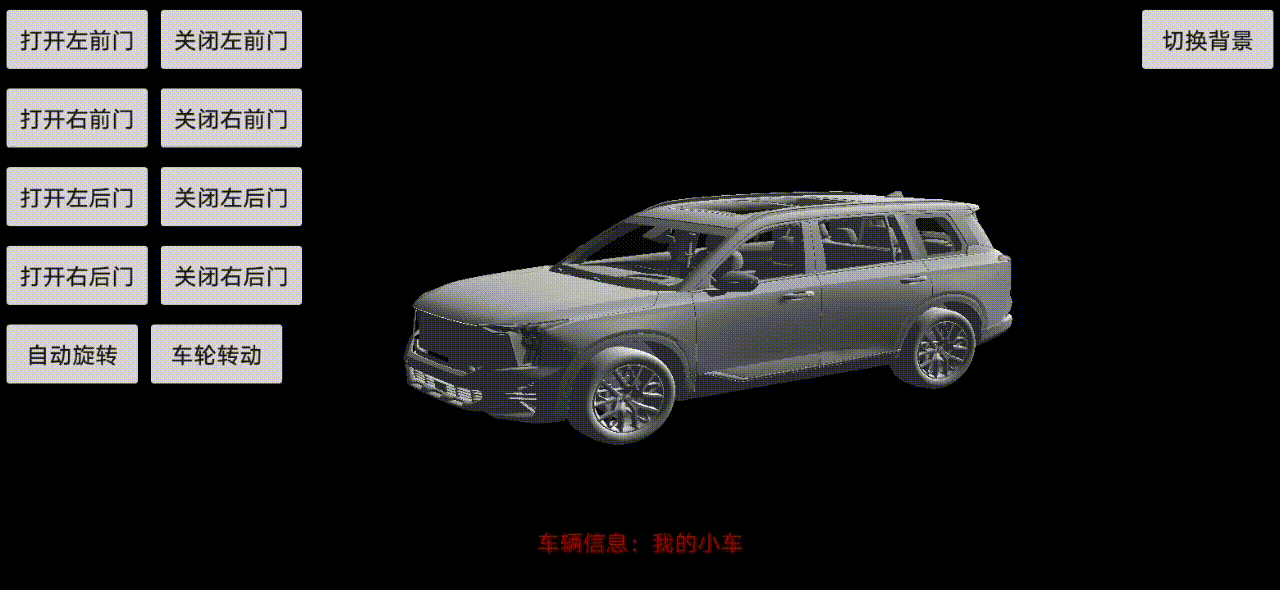
以上为打造Android车载3D车模桌面的全部内容,应用于车载主界面的开发,实现与众不同的车机效果。结合汽车网络,获取汽车数据可实现各种状态的同步显示效果,比如车速、车灯、车窗等。
完整效果看如下视频
打造车载3D车模桌面



















